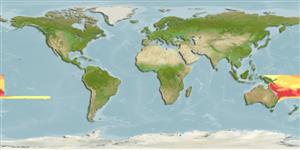Ελασμοβράγχιοι (καρχαρίες και σαλάχια) (sharks and rays) >
Squaliformes (Sleeper and dogfish sharks) >
Squalidae (Dogfish sharks)
Etymology: Squalus: Genus name from Latin 'squalus' meaning shark (Ref. 6885, 27436); grahami: Named for Ken Graham, a prominent ichthyologist of NSW Dept. of Primary Industries, Cronulla.
Eponymy: Kenneth ‘Ken’ John Graham (d: 1947), originally from New Zealand, spent his career as an ichthyologist, biologist and fisheries research scientist in Australia. [...] (Ref. 128868), visit book page.
More on authors: White, Last & Stevens.
Environment: milieu / climate zone / depth range / distribution range
Οικολογία
Θαλασσινό(ά); εύρος βάθους 148 - 504 m (Ref. 58442), usually 220 - 450 m (Ref. 58442). Tropical
Western Pacific: Australia.
Μέγεθος / Βάρος / Age
Maturity: Lm ? range ? - ? cm
Max length : 60.2 cm TL αρσενικό/απροσδιόριστο; (Ref. 58442); 71.1 cm TL (female)
Short description
Κλείδες προσδιορισμού | Μορφολογία | Μορφομετρία
This species is a moderate-sized one of the ‘mitsukurii group’ with the following set of characters: very elongate body, depth 10.1-12.6% TL; narrow, moderately long snout, preoral length 2.38-2.53 times its horizontal prenarial length, 10.5-11.3% TL, mouth width 1.54-1.77 (1.66) times its horizontal prenarial length; pre-first dorsal length is 28.9-31.3 (30.0)% TL; pre-second dorsal length is 60.2-62.7 (61.2)% TL; interdorsal space is 22.3-24.7 (23.8)% TL; dorsal fins are small, raked, first dorsal-fin height 6.3-7.2% TL; first dorsal-fin spine short and weak; second dorsal-fin spine slender with moderately broad base; prepectoral length 21.7-23.6 (22.4)% TL; pelvic-caudal space 24.0-26.5 (25.4)% TL; pectoral fin of adults slightly falcate; pectoral-fin inner margin relatively short, 7.1-7.8% TL; caudal bar almost upright, extending narrowly from the caudal fork up the posterior margin of the upper lobe for usually about 0.4 (rarely to 0.6) of its length in immature individuals, upper caudal fringe narrow, sometimes with a narrow central blotch on upper lobe; flank denticles are weakly tricuspidate; monospondylous centra 37-42, precaudal centra 80-87, total centra 105-116 (Ref. 58442).
Life cycle and mating behavior
Γεννητική Ωρίμανση | Αναπαραγωγή | Γεννοβολία | Αβγά | Γονιμότητα | Προνύμφες
Distinct pairing with embrace (Ref. 205).
White, W.T., P.R. Last and J.D. Stevens, 2007. Two new species of Squalus of the 'mitsukurii group' from the Indo-Pacific. pp. 71-81. In P.R. Last, W.T. White and J.J. Pogonoski Descriptions of new dogfishes of the genus Squalus (Squaloidea: Squalidae). CSIRO Marine and Atmospheric Research Paper No. 014. 130 pp. (Ref. 58442)
IUCN Red List Status (Ref. 130435: Version 2024-1)
Threat to humans
Harmless
Human uses
αλιεία: με δυνητικό ενδιαφέρον
Εργαλεία
Special reports
Download XML
Διαδικτυακές πηγές
Estimates based on models
Preferred temperature (Ref.
123201): 12.4 - 18.9, mean 15.6 °C (based on 46 cells).
Phylogenetic diversity index (Ref.
82804): PD
50 = 0.5000 [Uniqueness, from 0.5 = low to 2.0 = high].
Bayesian length-weight: a=0.00347 (0.00165 - 0.00730), b=3.09 (2.92 - 3.26), in cm total length, based on LWR estimates for this Genus-body shape (Ref.
93245).
Τροφικό Επίπεδο (Ref.
69278): 4.3 ±0.3 se; based on size and trophs of closest relatives
Ελαστικότητα (Ref.
120179): Χαμηλό, ελάχιστος χρόνος για διπλασιασμό πληθυσμού 4,5 - 14 έτη (Preliminary K or Fecundity.).
Fishing Vulnerability (Ref.
59153): Moderate to high vulnerability (48 of 100).
